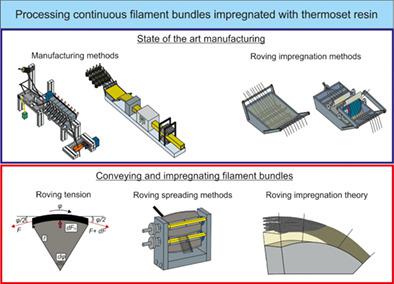当前位置:
X-MOL 学术
›
Polym. Compos.
›
论文详情
Our official English website, www.x-mol.net, welcomes your feedback! (Note: you will need to create a separate account there.)
An overview on current manufacturing technologies: Processing continuous rovings impregnated with thermoset resin
Polymer Composites ( IF 5.2 ) Pub Date : 2021-09-01 , DOI: 10.1002/pc.26274 Peter A. Arrabiyeh 1 , David May 1 , Maximilian Eckrich 1 , Anna M. Dlugaj 1
Polymer Composites ( IF 5.2 ) Pub Date : 2021-09-01 , DOI: 10.1002/pc.26274 Peter A. Arrabiyeh 1 , David May 1 , Maximilian Eckrich 1 , Anna M. Dlugaj 1
Affiliation

|
The demand for products made of fiber-reinforced polymer composites (FRPC) is constantly growing. These lightweight products are characterized by high stiffness, high tensile strength, and high service life. FRPC processes that employ thermoset-impregnated continuous rovings are easily automated and provide the products with the highest unidirectional tensile strength. A critical disadvantage of continuous fiber-reinforced polymers is caused by relatively high production costs. Among others, three main factors contribute to these production costs: (1) material costs, especially when carbon fibers are used, (2) costs for manufacturing semi-finished products, such as textiles or preimpregnated fabrics, and (3) costs for waste occurring along the entire chain of process steps. In this context, one group of processes shows outstanding characteristics: processes in which rovings are in situ impregnated with a thermoset resin and then directly processed. Wet filament winding and pultrusion are the most popular but not the only representatives of this group. For all these processes, in situ impregnation is the key element, and various technologies have been developed for this purpose, each with its own unique fluid-mechanical effects on rovings. A fundamental understanding of these effects is crucial to achieve products of the utmost quality. The paper at hand provides an overview of manufacturing processes that employ in situ impregnation of continuous rovings, specifically focusing on impregnation technologies. On this basis, phenomenological models describing the effects on the rovings during processing (impregnation, tension, and spreading) are reviewed.
中文翻译:

当前制造技术概述:加工用热固性树脂浸渍的连续粗纱
对由纤维增强聚合物复合材料 (FRPC) 制成的产品的需求不断增长。这些轻量化产品具有高刚度、高抗拉强度和高使用寿命的特点。采用热固性浸渍连续粗纱的 FRPC 工艺很容易实现自动化,并为产品提供最高的单向拉伸强度。连续纤维增强聚合物的一个关键缺点是由相对较高的生产成本造成的。其中,三个主要因素导致这些生产成本:(1) 材料成本,尤其是在使用碳纤维时,(2) 制造半成品的成本,如纺织品或预浸渍织物,以及 (3) 废料成本发生在整个流程步骤链中。在此背景下,一组工艺表现出突出的特点:粗纱原位浸渍热固性树脂,然后直接加工的工艺。湿法长丝缠绕和拉挤是最流行的,但不是该组的唯一代表。对于所有这些工艺,原位浸渍是关键要素,为此目的开发了各种技术,每种技术对粗纱都有其独特的流体力学影响。对这些影响的基本了解对于获得最高质量的产品至关重要。手头的论文概述了采用连续粗纱原位浸渍的制造工艺,特别关注浸渍技术。在此基础上,回顾了描述加工(浸渍、张力和铺展)过程中对粗纱的影响的现象学模型。
更新日期:2021-11-09
中文翻译:

当前制造技术概述:加工用热固性树脂浸渍的连续粗纱
对由纤维增强聚合物复合材料 (FRPC) 制成的产品的需求不断增长。这些轻量化产品具有高刚度、高抗拉强度和高使用寿命的特点。采用热固性浸渍连续粗纱的 FRPC 工艺很容易实现自动化,并为产品提供最高的单向拉伸强度。连续纤维增强聚合物的一个关键缺点是由相对较高的生产成本造成的。其中,三个主要因素导致这些生产成本:(1) 材料成本,尤其是在使用碳纤维时,(2) 制造半成品的成本,如纺织品或预浸渍织物,以及 (3) 废料成本发生在整个流程步骤链中。在此背景下,一组工艺表现出突出的特点:粗纱原位浸渍热固性树脂,然后直接加工的工艺。湿法长丝缠绕和拉挤是最流行的,但不是该组的唯一代表。对于所有这些工艺,原位浸渍是关键要素,为此目的开发了各种技术,每种技术对粗纱都有其独特的流体力学影响。对这些影响的基本了解对于获得最高质量的产品至关重要。手头的论文概述了采用连续粗纱原位浸渍的制造工艺,特别关注浸渍技术。在此基础上,回顾了描述加工(浸渍、张力和铺展)过程中对粗纱的影响的现象学模型。



























 京公网安备 11010802027423号
京公网安备 11010802027423号